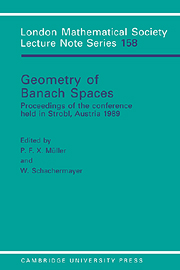Book contents
- Frontmatter
- Contents
- Foreword
- List of Main Lectures
- List of Participants
- A note on H. Ishihara and W. Takahashi modulus of convexity
- A property of non-strongly regular operators
- The entropy of convex bodies with ‘few’ extreme points
- Spaces of vector valued analytic functions and applications
- Notes on approximation properties in separable Banach spaces
- Moduli of complex convexity
- Grothendieck type inequalities and weak Hilbert spaces
- A weak topology characterization of l1 (m)
- Singular integral operators: a martingale approach
- Remarks about the interpolation of Radon-Nikodym operators
- Symmetric sequences in finite-dimensional normed spaces
- Some topologies on the space of analytic self-maps of the unit disk
- Minimal and strongly minimal Orlicz sequence spaces
- Type and cotype in Musielak-Orlicz spaces
- On the complex Grothendieck constant in the n-dimensional case
- Pathological properties and dichotomies for random quotients of finite-dimensional Banach spaces
- A note on a low M*-estimate
- The p1/p in Pisier's factorization theorem
- Almost differentiablity of convex functions in Banach spaces and determination of measures by their values on balls
- When E and E[E] are isomorphic
- A note on Gaussian measure of translates of balls
- Sublattices of M(X) isometric to M[0,1]
Notes on approximation properties in separable Banach spaces
Published online by Cambridge University Press: 03 May 2010
- Frontmatter
- Contents
- Foreword
- List of Main Lectures
- List of Participants
- A note on H. Ishihara and W. Takahashi modulus of convexity
- A property of non-strongly regular operators
- The entropy of convex bodies with ‘few’ extreme points
- Spaces of vector valued analytic functions and applications
- Notes on approximation properties in separable Banach spaces
- Moduli of complex convexity
- Grothendieck type inequalities and weak Hilbert spaces
- A weak topology characterization of l1 (m)
- Singular integral operators: a martingale approach
- Remarks about the interpolation of Radon-Nikodym operators
- Symmetric sequences in finite-dimensional normed spaces
- Some topologies on the space of analytic self-maps of the unit disk
- Minimal and strongly minimal Orlicz sequence spaces
- Type and cotype in Musielak-Orlicz spaces
- On the complex Grothendieck constant in the n-dimensional case
- Pathological properties and dichotomies for random quotients of finite-dimensional Banach spaces
- A note on a low M*-estimate
- The p1/p in Pisier's factorization theorem
- Almost differentiablity of convex functions in Banach spaces and determination of measures by their values on balls
- When E and E[E] are isomorphic
- A note on Gaussian measure of translates of balls
- Sublattices of M(X) isometric to M[0,1]
Summary
Introduction, definitions and discussion of results.
Although the example given by Enflo in 1973 [5] settled the approximation problem and the basis problem for Banach spaces, a number of closely related problems have continued to arouse interest. If X is a separable Banach space, there are a number of natural properties intermediate between X having the approximation property and having a basis.
Let us first make some definitions. Suppose X is a separable Banach space. Then X has the approximation property (AP) if there is a net of finite-rank operators Tα so that Tαx → x for x ∈ X, uniformly on compact sets. is said to have the bounded approximation property (BAP) if this net can be replaced by a sequence Tn; alternatively X has (BAP) if there is a sequence of finite-rank operators, Tn, such that sup Tn∥ > ∞ and Tnx → x for x ∈ X. A sequence Tn with these properties will be called an approximating sequence. If X has an approximating sequence Tn with limn → ∞ ∥Tn∥ = 1 then X has the metric approximation property (MAP).
An important principle [15] that we will use frequently is that if Tn is any approximating sequence for X then there is an approximating sequence Sn satisfying SmSn = Sn whenever m > n and such that for some subsequence Tkn of Tn then limn → ∞∥Tkn − Sn∥ = 0. (See Lemma 2.4 of [15]).
- Type
- Chapter
- Information
- Geometry of Banach SpacesProceedings of the Conference Held in Strobl, Austria 1989, pp. 49 - 64Publisher: Cambridge University PressPrint publication year: 1991
- 5
- Cited by

